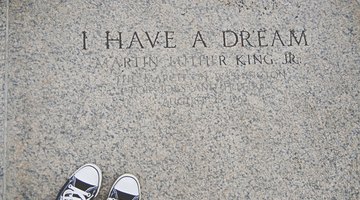There have been many influential speeches given by famous leaders throughout history. Whether it was the Gettysburg Address by Abraham Lincoln or John F. Kennedy's First Inaugural Address, these speeches resonated with people around the world, so much so that they still talk about them today. One speech that truly made a difference in American history was Dr. Martin Luther King Jr.'s "I Have a Dream Speech," which gave off a mood that resonated with people for decades.
What Is "Mood?"
When you think of the word "mood" it's always directly associated with a feeling. The term has almost the same definition when it applies to a piece of literature or text, like a speech. The mood of a piece of writing is its "atmosphere" and the sense of emotional feeling a person experiences when reading or listening to it. There's no question that the "I Have a Dream Speech" by Dr. Martin Luther King Jr. evoked a series of emotions.
Background of the Speech
Martin Luther King Jr.'s "I Have a Dream" speech was the epicenter of the Civil Rights Movement in the United States. During the 1960s, African-Americans fought for their civil rights against racial discrimination and segregation, primarily in the South. African-Americans lived in a world where they couldn't use facilities frequented by whites, while their facilities were at a much lower standard. The Civil Rights Act allowed for federal protection of their rights.
Unfortunately, this fight was not an easy one. African-Americans fell victim at the hands of others who did not feel they deserved those rights. Because of this, they had to go through extraordinary measures to have their voices heard. Militant activist groups, like the Black Panthers, banded together to fight and protest against racial oppression.
When the Civil Rights Act was discussed in Congress, African-Americans needed more of a push to get it passed. This led to the March on Washington in 1963, where people attended in support of the act. Dr. Martin Luther King Jr., a Baptist minister and social activist, was one of the speakers at the march, and though it's believed that he had trouble coming up with points for the speech, his words ended up becoming some of the most influential of the 1900s.
The Mood of the "I Have a Dream" Speech
If it weren't for singer Mahalia Jackson yelling out to Dr. King during his speech, the "I Have a Dream" speech as we know it today may have never happened. Dr. King had been threading this "dream" through several other speeches he had given prior to the March on Washington, where he said those legendary words_, "I have a dream that my four little children will one day live in a nation where they will not be judged by the color of their skin but by the content of their character."_
The mood of the speech can be interpreted in many ways, considering every person experiences emotions differently than the person next to them. It's clear that Dr. King wanted his audience to feel inspired, hopeful, motivated and powerful. The mood of his speech encouraged people to persevere to fight for the rights of their brothers and sisters.
The Reactions and Results of the Speech
Though most people today associate positive feelings with Dr. Martin Luther King Jr.'s "I Have a Dream" speech, that wasn't quite the case at the time when he gave it. Many political leaders felt as though African-Americans should have been content with their current situation, instead of asking for more.
But, because Dr. King was so successful at expressing the mood of his speech, even if that wasn't his initial intention, many believe that it was because of this that Congress finally took action. The mood of a speech is supposed to allow the listeners to fully understand what the speaker wants to convey to them. It's no surprise, then, that the speech was successful at portraying such a widely-felt mood, as shortly after, the Civil Rights Act was finally passed.
Related Articles
References
Writer Bio
Hana LaRock is a freelance content writer from New York, currently living in Mexico. Before becoming a writer, Hana worked as a teacher for several years in the U.S. and around the world. She has her teaching certification in Elementary Education and Special Education, as well as a TESOL certification. Please visit her website, www.hanalarockwriting.com, to learn more.










